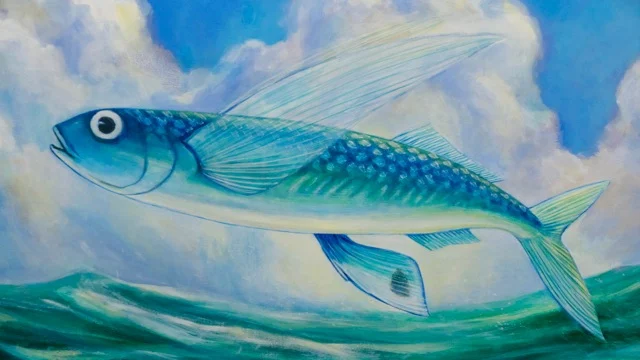
Mary Gardner
In 1891, when Mary Malloy was 15, the plague erupted in Sydney. Her father and two brothers died. Her mother, a nurse, took up a new position in Byron Bay. They travelled from the city on the steamer Ellen Nicoll. The passage was rough and many people were seasick. But not Mary. Decades later, as Mrs Flick-Harrison, she wrote she ‘enjoyed the rough seas’. The boat waited at sea for a few hours before traffic cleared and they could reach the jetty at Main Beach. A queue into town was common even back in 1891. But what also deeply impressed her on that voyage was seeing ‘quite a lot of flying fish’, some of which ‘ended up on the deck’.
The 50 or 60 species of flying fish actually glide through the air. Accelerating underwater at a speed of more than 30 body lengths per second, they dart forward and up, spreading their wide fins like fans. Their tails beat the water 50 times a second. Although their body size is modest (only 150–500mm in length), they soar a distance of one to four hundred metres.
Perhaps the fish are escaping underwater predators such as tuna, only to be exposed to hungry birds like boobies and terns. Maybe they have long distances to travel: large home ranges with scattered hot spots of their favourite prey? Surprisingly little is known about most species. They are vital to indigenous and artisanal fishers throughout the subtropics and tropics in every ocean. But now commercial fishing is making its impact.
One example is in Taiwan, where 14 indigenous groups are officially recognised. One tribe, the Tao, revere the flying fish. Each year, their festivals summon the fish and participants closely supervise the fishing effort. But the Taos are less than two per cent of the population. Other people in Taiwan harvest the fish commercially, processing the eggs as tobiko. This brightly orange, black and green caviar fetches good money in the global sushi market. This take of breeding females is so large that there are now calls for ‘no take’ marine reserves centred on the Taiwanese spawning areas.
The sustainable sushi movement includes tobiko in ‘black box seafood’: a popular product, drawn from poorly understood fishery and as such, unsustainable. Complicating commerce is that Taiwan, like Japan, is a centre for processing. That’s how a Taiwanese or Japanese label ends up on eggs which are freighted in from far away seas. One strange flight for unborn flying fish.
Left to themselves, some species of flying fish spawn in great orgies. Others mate in pairs. Some spawn where they spend their whole life – in the open ocean. Others are coastal and spawn in bays or near shore. Some are reported to ride a wave ashore, spawning and returning to the sea as the wave ebbs. All have unique eggs with tendrils that hook onto floating algae, coconuts, logs, pumice or plastics where they drift till hatching.
Flying fish, the Exocoetidae, are deep-time creatures from 65 million years ago. From 12,000 years ago, they starred in the lives and legends of people who settled in Taiwan and then navigated across the great Pacific Ocean.
By the time the great sailors reached Hawaii in AD400, they had spread the name mālolo throughout Polynesia. This also became the name of the first luxury cruise liner, sailing from Honolulu in the 1920s. It’s also the name of the Polynesian seagoing outrigger in Bonville’s historical novel Voyages of Mālolo.
After World War ll, when Heyerdahl and Alsar sailed balsa rafts from South America to Tahiti and Ballina, the crews were awakened by the night flights of flygefisk or volador leaping aboard. Last year, moviegoers glimpsed a similar experience in the films Kon Tiki and The Life of Pi.
Flying fish evoke great wonder and prod our ignorance. Rather than eating the future, ask your sushi bar for a vegetarian alternative. Or to source Icelandic masago (capelin eggs). Talk with your whale-watching boat operator about any local sightings of these iridescent fish. Experience a sustainable soul food event you can write about in your own memoirs.
See more about fish and activism at www.sustainablesushi.net.



